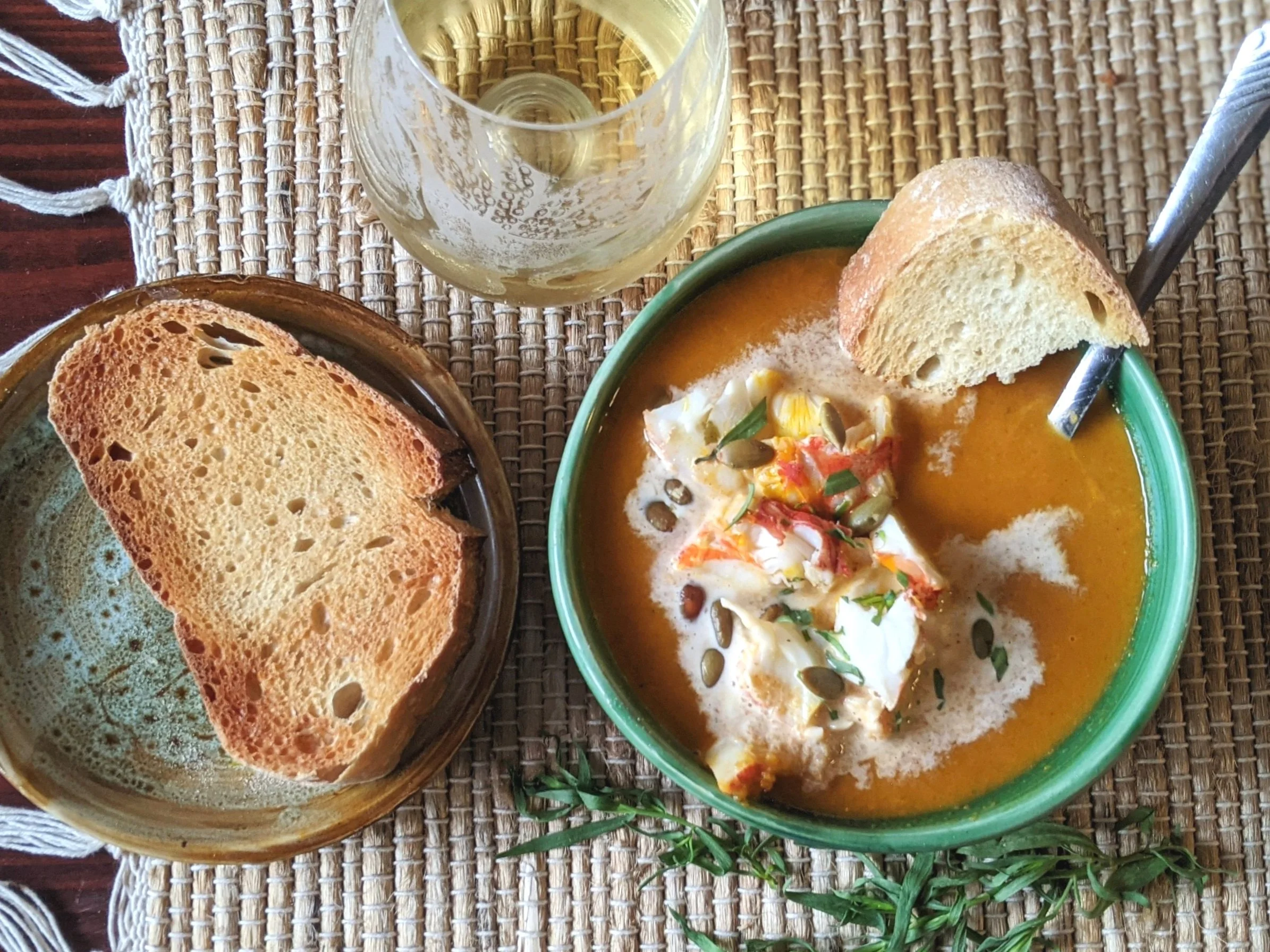Spiny Lobster Pumpkin Bisque
Enjoy your Spiny Lobster Pumpkin Bisque with a warm piece of sourdough and a cold glass of the white wine you cooked with.
Photo Credit: Emily Miller
Ingredients
1 whole spiny lobster
1 large white or yellow onion, chopped
3 medium carrots, chopped
3 stalks celery, diced
4 cloves garlic, smashed
3 tablespoons tomato paste
3 tablespoons canned pumpkin
3 tablespoons all-purpose flour
3 tablespoons unsalted butter
1/3 teaspoon ground nutmeg
1/3 teaspoon ground cinnamon
1 teaspoon cayenne pepper
1½ cups dry white wine, divided
½ cup dry sherry
6 cups lobster stock (see recipe)
1 sprig fresh tarragon
1 cup heavy cream
1 teaspoon lemon juice
salt and fresh cracked pepper to taste
salted pepitas (optional) for garnish
For Lobster Stock
Lobster head, shells, legs
2 cloves garlic, smashed
3 tablespoons unsalted butter
1 bay leaf
10 cups water
Spiny lobster season is synonymous with fall (see our blog post, Diving Into Spiny Lobster Season to learn more about the fishery and the spiny lobsters themselves). Lobster bisque is a natural choice for anyone looking to make the most of the season - and a pumpkin twist to this traditionally tomato-based bisque makes it twice as festive for the fall.
The main source of lobster flavor in a bisque are the shells used to make the stock, not the meat (meat is used to top the bisque). The secret to achieving a strong flavor, and deep orange-pink color to your bisque, lies in blending the lobster body/shells and sautéing in butter to extract fat-soluble flavor. Without a blender, manually breaking shells with a mallet will work similarly well.
Happy Halloween!
How to Prepare:
First you must make your lobster stock - this can be done ahead of time with shells you’ve saved (frozen) from past spiny lobster meals, or as follows.
Make Lobster Stock:
Steam whole spiny lobster for 8-10 minutes. Remove tail meat and reserve in refrigerator for bisque.
Add the rest of the lobster, legs and all, to a countertop blender and add 1 cup white wine, 1 cup water. Blend in pulses - avoid grinding shells down to dust. Stop when largest pieces of lobster shells are fragmented into pieces around 1-inch across.
Add slurry and lobster shell fragments to a large stockpot over medium-high heat. Bring to a boil, then turn down heat to simmer when liquid has mostly evaporated off. Add 3 tablespoons of unsalted butter and sauté lobster shells, stirring frequently, for 3 minutes.
Add 10 cups of water and 1 bay leaf to shells in stockpot and bring to a boil, then turn down to simmer for 1 hour or longer. Strain solids and use stock in bisque.
For the Bisque:
At the bottom of a large stockpot over medium-low heat, sauté garlic, onion, carrots, and celery with 2 tablespoons unsalted butter for 10 minutes until softened.
Add spices, fresh tarragon, tomato paste, canned pumpkin and three tablespoons of flour. Stir to combine, then add 1/2 cup white wine and 1/2 cup sherry.
Turn up the heat to medium-high until half the liquid is evaporated, then add 6 cups lobster stock and bay leaf. Simmer ingredients together over low heat for 1 hour, then use immersion blender or countertop blender to blend contents of stockpot. If using a countertop blender, allow stockpot contents to cool before blending. Blend until creamy - a strainer can be used to achieve the right texture if your blender is not powerful enough.
4. If using a countertop blender, return to stockpot. Taste contents and add salt and pepper to your preference. Add 1 cup heavy cream to hot stockpot contents and stir to mix.
5. Remove lobster meat from refrigerator and chop into 1-inch pieces. When plating, add bisque to bowls, top with lobster meat, and garnish with pepitas. Serve with toasted sourdough and enjoy.


